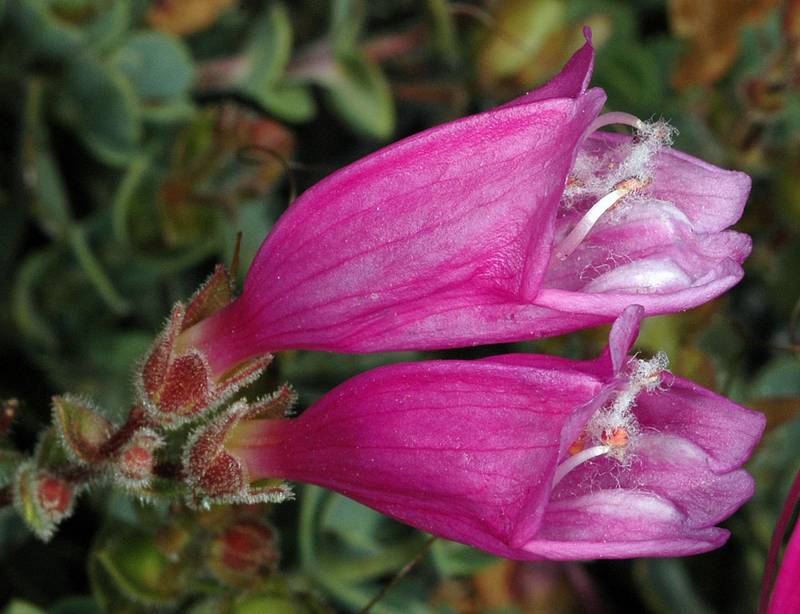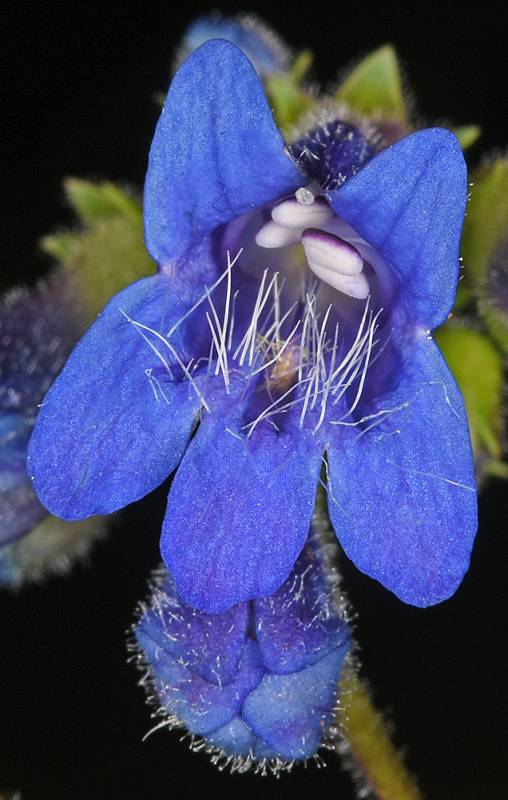|
cliff beardtongue, rock penstemon
|
Wilcox's beardtongue
|
| Basally shrubby, mat-forming perennial, the spreading-hairy, erect or ascending stems up to 1 dm. tall. |
Perennial from a branched, woody base, the clustered stems 3-10 dm. tall, usually glabrous except for the inflorescence |
Mat leaves thick and firm, glaucous, glabrous or with short, spreading hairs, irregularly serrulate, the broadly elliptic or obovate blade 8-18 mm. long; leaves of the flowering shoots opposite, few, less than 1 cm. long. |
Leaves opposite, strongly serrate with slender teeth, the basal leaves well-developed, elliptic to deltoid-ovate, the blade up to 9 cm. long and 5 cm. wide, about equal to the petiole; cauline leaves often larger than the basal, sessile, 4-10 cm. long and 1.5-4 cm. wide. |
Inflorescence a compact, few-flowered raceme, glandular-hairy; calyx 6-11 mm. long, the 5 segments narrowly lance-elliptic to ovate-oblong; corolla bright pink to rose-purple, 25-35 mm. long, keeled on the back, usually glabrous inside and out; anthers long-woolly; pollen sacs wholly dehiscent and opening wide enough to form a plane; staminode slender, shorter that the fertile filaments, nearly glabrous. |
Inflorescence of several large, loose verticillasters; calyx 2.5-5 mm. long, the 5 segments broadly lanceolate, narrowly scarious-margined; corolla blue, the paler throat with guide lines, 15-23 mm. long, the tube 4-8 mm. wide at the mouth, glandular-hairy on the outside, strongly bilabiate, the lower lip much longer than the upper, the raised portion bearded; pollen sacs 0.7-1.0 mm. long, wholly dehiscent, becoming opposite, glabrous; staminode with a recurved, bearded tip. |
Capsule |
Capsule 4-6 mm. long. |
|
|
|
|
| May-August |
May-July |
| Rock cliffs and rocky slopes from middle elevations in the mountains to the alpine. |
Open or often wooded, sometimes in rocky places, from the foothills to moderate elevations in the mountains. |
Occurring on both sides of the Cascades crest and in the Columbia River Gorge in Washington; Washington to California.
|
Occurring east of the Cascades crest in eastern Washington; Washington to Oregon, east to Montana.
|
| Native |
Native |
| Not of concern |
Threatened in Washington (WANHP) |
P. acuminatus, P. attenuatus, P. barrettiae, P. cardwellii, P. cinereus, P. confertus, P. davidsonii, P. deustus, P. ellipticus, P. eriantherus, P. euglaucus, P. fruticosus, P. gairdneri, P. glandulosus, P. hesperius, P. lyallii, P. ovatus, P. palmeri, P. pennellianus, P. procerus, P. pruinosus, P. richardsonii, P. rydbergii, P. serrulatus, P. speciosus, P. subserratus, P. triphyllus, P. venustus, P. washingtonensis, P. wilcoxii |
P. acuminatus, P. attenuatus, P. barrettiae, P. cardwellii, P. cinereus, P. confertus, P. davidsonii, P. deustus, P. ellipticus, P. eriantherus, P. euglaucus, P. fruticosus, P. gairdneri, P. glandulosus, P. hesperius, P. lyallii, P. ovatus, P. palmeri, P. pennellianus, P. procerus, P. pruinosus, P. richardsonii, P. rupicola, P. rydbergii, P. serrulatus, P. speciosus, P. subserratus, P. triphyllus, P. venustus, P. washingtonensis |
| |



